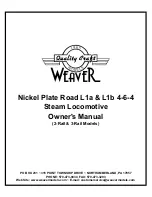
GRAUPNER GmbH & Co. KG D-73230 KIRCHHEIM/TECK GERMANY
No liability for printing errors. Technnical modifications reserved.
#0060384
04/2009
48
cut ABS parts as brackets. Particular rollers - especially the vertical ones, and those which are severely
stressed - should be fitted with a length of 0.8 mm Ø steel wire inside the sleeve axle, forming an inner axle.
The ends of the steel wire should project by about 4 mm, and can then be bent over at right-angles to
prevent the axle slipping out.
TIP:
an alternative method is to cut the wire core in the centre, bend the ends
over, then insert one piece from each end and glue them in place.
In the case of the less highly stressed axles it is sufficient to leave the snake inner sleeve slightly over-
length, fit the mounting brackets, then cut the sleeve neatly to the correct length. It is important that the tube
should not be crimped or squashed at the ends, so please avoid cutting them to length with side-cutters or
scissors. If the ends are not a good fit in the brackets, there is a chance that the rollers will be pushed out of
the brackets when under load.
Painting
•
We recommend that you ask your local model shop or paint dealer for advice on the best paints to use.
•
Always observe the application notes supplied with the paints.
•
Use
ONLY
paints of the same make and type, otherwise the materials may react when in contact, and
attack or dissolve each other or produce unsightly bubbles. Be particularly careful when combining
spray-can paints and brushing types; always carry out a test beforehand on a scrap piece of material, to
check whether the paints are compatible with each other.
•
The surfaces must be rubbed down beforehand to ensure that the paint adheres well. Use fine-grade
wet-and-dry paper (600-grit to 800-grit) for this, then remove all traces of grease from the surface using a
non-greasy liquid detergent or white spirit. Make every effort to avoid touching the cleaned surface
before the paint is applied, as perspiration will deposit a new layer of grease on the surface.
•
All areas which are not to be painted must be masked off completely. Seal all holes, slots and openings
with tape, as the fine mist of paint will find its way into any opening, no matter how small.
•
Where you wish to mask off neat, straight edges, use as narrow an adhesive tape as possible, e.g. trim-
stripe tape. Apply the tape neatly and accurately, without placing it under tension, then cover the
remaining areas with paper masking tape and scrap paper or film.
•
Before starting construction please consider carefully how and in which sequence you intend to paint the
model, or simply keep to the sequence recommended in the building instructions. Note that some parts
will be difficult or even impossible to paint once glued in place.
•
TIP:
a good method of painting small parts is to attach them temporarily to a scrap hardwood stick or
similar holder using double-sided tape, fixing them by the joint surface. The part can then be painted in
one “go”, then removed from the tape and attached to the model once the paint is dry.
Colour scheme
The list below states only the RAL colours, as this will make it easier for you to find the correct hues. Armed
with this information you can ask any paint supplier or specialist model shop to prepare the paints for you.
Let your advisor in the paint shop know exactly how you intend to use the material, as this will help him
select the correct grade. We recommend synthetic enamels; never use cellulose paints!
Exposed hull, superstructure, bulwark, deck-boxes, mast, small items,
guard bars, railings, searchlights, fire monitor plinth
RAL 9016
Submerged
hull
RAL
3009
Decks, stern cradle, bollards, small items, companionway steps
RAL 6001
Command stand, inside surface of bulwarks
RAL 6019
Fluorescent paint for superstructure and mast
RAL 3024
Fender rail, searchlights, loudhailers,
anchor
RAL
9006
Bulwark
fenders,
lifebelts
RAL
2003
Ball-fenders
RAL
2002
Fire
monitor
RAL
3000
Upper part of exhaust fairing, parts of guard bar,
bow flagstock, upper area of jumping sheet masts
RAL 9005
Assignment of roof registrations to ship’s names
Hermann
Rudolf
Meyer
DBAC
Hans Hackmack
DBAT
Bernhard
Gruben
DBBS
Theo
Fischer
DBBR
Care and maintenance
•
Clean the model carefully after every run, and remove any water which penetrates the hull. If water gets
















































